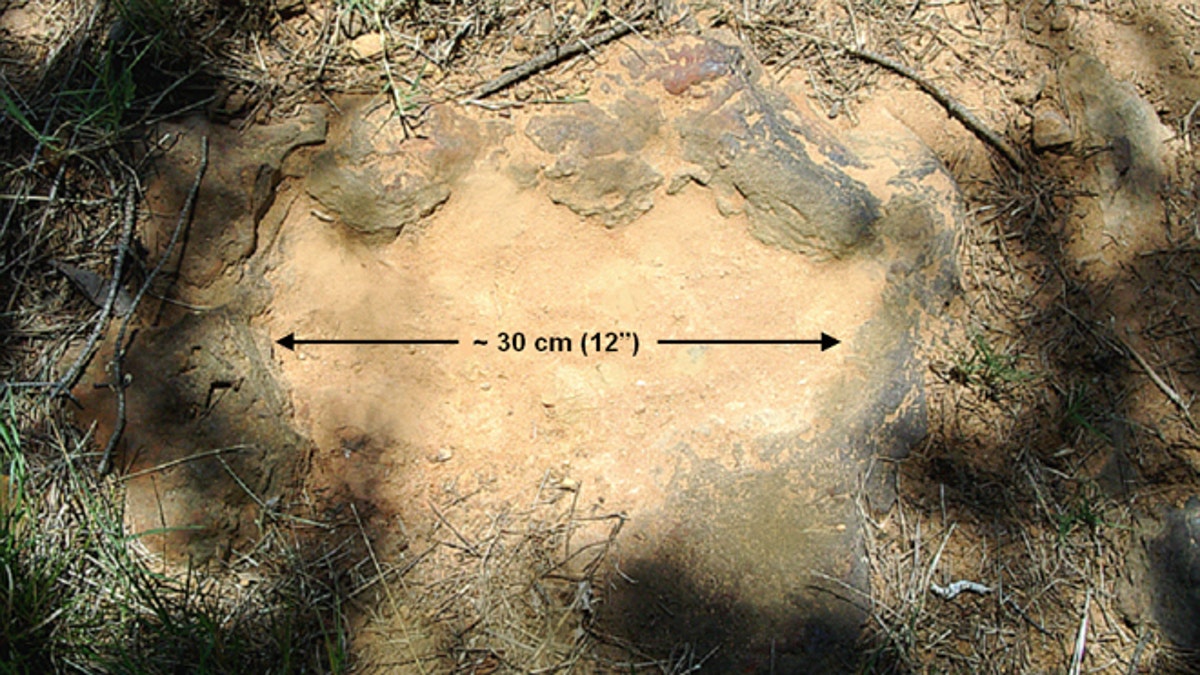
The 12-inch-wide footprint belonged to an armored, tank-like plant-eater. (NASA/GSFC/Rebecca Roth)
A chunk of stone bearing dinosaur footprints has been carefully lifted from the grounds of NASA's Goddard Space Flight Center in Greenbelt, Md., scientists report.
The dino tracks, thought to have been left by three separate beasts more than 100 million years ago, were discovered by amateur paleontologist Ray Stanford in August 2012.
The feature that first caught Stanford's eye was a dinner-plate-sized footprint of a nodosaur, a tanklike dinosaur studded with bony protuberances that roamed the area about 110 million years ago during the Cretaceous period (the period from 145 million to 65 million years ago that was the end of the Mesozoic Era). This particular lumbering leaf-eater must have been moving quickly across the prehistoric mud, as its heel did not sink deeply into the ground.
[pullquote]
A closer look at the site revealed two more prints. Stephen Godfrey, a paleontology curator at the Calvert Marine Museum, who was contracted to preserve the find, said he suspects one was left by an ornithopod, possibly from the iguanodontid family, which were large vegetarian dinosaurs with birdlike, three-toed feet that walked on its hind legs. Another smaller footprint found superimposed over the nodosaur track is thought to be from a baby nodosaur, perhaps trying to catch up to its parent, according to a statement from NASA. [See Photos of the Dinosaur Footprints at Goddard]
The stretch of ground containing the prints measured about 7 feet long and 3 feet across at its widest point. After making a silicon-rubber cast of the dino tracks, the team covered the find in plaster-soaked burlap, much like an orthopedic cast, to reinforce the slab and protect it from damage during the big move. Altogether, the stone slab, the protective jacket and surrounding soil weighed about 3,000 pounds, and it was successfully pulled out of the ground last month.
For now, the prints are being stored at Goddard until further scientific study is possible. The wonder of the discovery has not been lost on space scientists at Goddard, who often find themselves studying starlight as old as the dinosaurs.
"One of the amazing aspects of this find is that some of the starlight now seen in the night sky by astronomers was created in far-distant galaxies when these dinosaurs were walking on mud flats in Cretaceous Maryland where Goddard is now located," Jim Garvin, Goddard's chief scientist, said in a statement. "That starlight (from within the Virgo Supercluster) is only now reaching Earth after having traveled through deep space for 100 million years."
Copyright 2013 LiveScience, a TechMediaNetwork company. All rights reserved. This material may not be published, broadcast, rewritten or redistributed.
